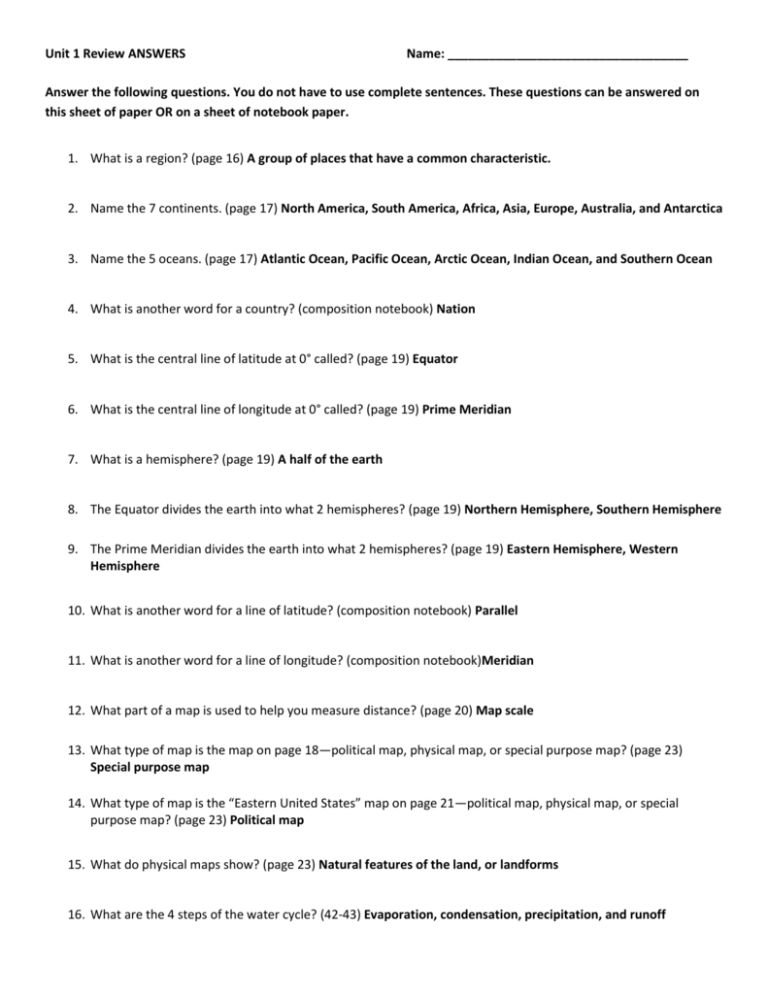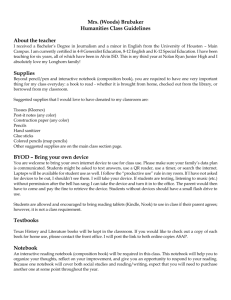Unit 1 Review ANSWERS Name: Answer the following questions
advertisement

Unit 1 Review ANSWERS Name: ___________________________________ Answer the following questions. You do not have to use complete sentences. These questions can be answered on this sheet of paper OR on a sheet of notebook paper. 1. What is a region? (page 16) A group of places that have a common characteristic. 2. Name the 7 continents. (page 17) North America, South America, Africa, Asia, Europe, Australia, and Antarctica 3. Name the 5 oceans. (page 17) Atlantic Ocean, Pacific Ocean, Arctic Ocean, Indian Ocean, and Southern Ocean 4. What is another word for a country? (composition notebook) Nation 5. What is the central line of latitude at 0° called? (page 19) Equator 6. What is the central line of longitude at 0° called? (page 19) Prime Meridian 7. What is a hemisphere? (page 19) A half of the earth 8. The Equator divides the earth into what 2 hemispheres? (page 19) Northern Hemisphere, Southern Hemisphere 9. The Prime Meridian divides the earth into what 2 hemispheres? (page 19) Eastern Hemisphere, Western Hemisphere 10. What is another word for a line of latitude? (composition notebook) Parallel 11. What is another word for a line of longitude? (composition notebook)Meridian 12. What part of a map is used to help you measure distance? (page 20) Map scale 13. What type of map is the map on page 18—political map, physical map, or special purpose map? (page 23) Special purpose map 14. What type of map is the “Eastern United States” map on page 21—political map, physical map, or special purpose map? (page 23) Political map 15. What do physical maps show? (page 23) Natural features of the land, or landforms 16. What are the 4 steps of the water cycle? (42-43) Evaporation, condensation, precipitation, and runoff 17. What happens in the evaporation step of the water cycle? (page 42) The sun heats the water, causing the water to change from a liquid to a gas (water vapor) and rise into the air. 18. What happens in the condensation step of the water cycle? (page 42) The water vapor cools as it rises in the atmosphere, forming droplets (condensation) that, together, form clouds. 19. What happens in the precipitation step of the water cycle? (page 43) Water droplets grow heavier and fall back to earth as rain, snow, sleet, or hail. 20. What happens in the runoff step of the water cycle? (page 43) Precipitation soaks into the ground and runs into rivers, underground water reservoirs (aquifers) and, eventually, the ocean. 21. In areas with hotter climates, what happens to the water cycle? (answer not in book—think it through) The water cycle speeds up, leading to more rain. 22. What is climate? (page 44) The average temperature and precipitation over a long period of time. 23. What is weather? (page 45) The condition of the atmosphere at a particular time. 24. What is the difference between climate and weather? (page 44-45) Climate is an average over a long period of time; weather is what is happening moment to moment. 25. What are the 4 factors of climate? (page 44 or composition notebook) Latitude, elevation, prevailing winds, ocean currents. 26. What is the rule for how latitude affects climate? (composition notebook) Places farther from Equator are colder. Places nearer to Equator are warmer. 27. How do prevailing winds and ocean currents affect climate? (composition notebook) Prevailing winds or ocean currents coming from colder areas bring colder temperatures; prevailing winds or ocean currents from warmer areas bring warmer temperatures. 28. What is an economy? (page 62) A system for making, selling and buying, or distributing, goods and services 29. What are the three levels of economic activity? (page 62 or composition notebook) Primary, secondary, and tertiary 30. What do people do in the primary level of economic activity? (page 62 or composition notebook) Gather raw materials 31. What do people do in the secondary level of economic activity? (page 62 or composition notebook) Make raw materials into finished products 32. What do people do in the tertiary level of economic activity? (page 62 or composition notebook) Provide services 33. What are the four main economic systems? (page 62 or composition notebook) Traditional system, free enterprise system, command system, and mixed system. 34. Who makes the decisions about what goods to create and how to sell them in a free enterprise economy? (page 62 or composition notebook) Individuals, or business owners 35. Who makes the decisions about what goods to create and how to sell them in a command economy? (page 62 or composition notebook) The government 36. What is the gross domestic product? (page 62 or composition notebook) Total dollar value of all goods and services produced in a country in a year 37. What is per capita GDP? (composition notebook) GDP per person (GDP ÷ population) 38. What is literacy rate? (composition notebook) Percentage of people in a country who can read 39. What is infant mortality rate? (composition notebook) Number of infants who die, out of 1,000 40. What is life expectancy? (composition notebook) Average number of years a person is expected to live 41. What is income? (composition notebook) How much money a person earns in a year 42. Developed countries will have what kind of GDP—high or low? High 43. Developing countries will have what kind of literacy rate—high or low? Low 44. Developed countries will have what kind of life expectancy—high or low? High 45. Developed countries will have what kind of infant mortality rate—high or low? Low









